Guatemala
Things to Do
Guatemala City
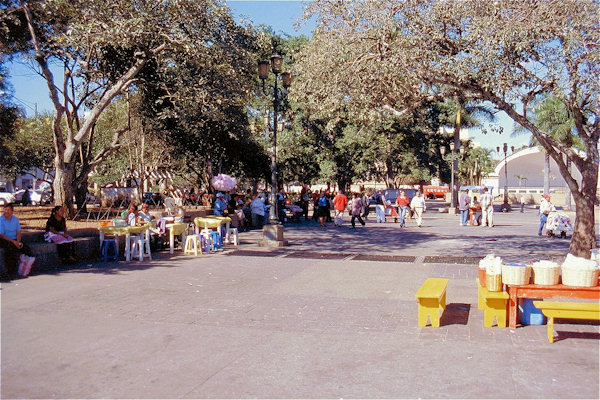 |
|||||
The standard colonial urban-planning scheme required every town in the New World to have a large plaza for military exercices
and ceremonies. On the north side of the plaza was usually the Palacio de Gobierno (colonial gouvernement headquaters).
On another side, preferably the east, would be a church (or cathedral) and on the other sides of the square there could be additional
civic buildings
On the north side of the Parque Central is the imposing Palacio Nacional de la Cultura, built as a presidential palace
between 1936 and 1943. Architecturally the palace is one of the country's most interresting conctructions, a melange of multiple
earlier styles from Spanish Renaissance to Neoclassical. Today, most government offices have been removed from here and it's open as
a museum and for ceremonial events.
The Catedral Metropolitana was constructed between 1782 and 1815. (the towers where finished in 1867) it has survived earthquake
and fire well, though the quake of 1917 did substantial damage and the one of 1976 did even more.
Antigua
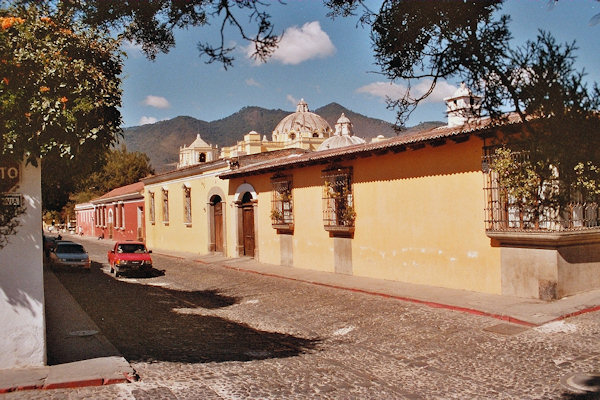 |
|||||
Antiqua was founded on march 10, 1543, as the Spanish colonial capital of Guatemala.
During the 17th and 18th centuries, little expense was spared on the city's magnificent architecture. At its peak Antiqua had no
fewer than 38 churches, including a cathedral.
The Great Earthquake of 1773 destroyed the city and the capital was transferred to Guatemala City.
After the earthquake, Antiqua was evacuated and plundered for building materials but never completely emptied of people, and began
to grow again around 1830. Renovation of battered old buildings helped maintain the city's colonial character and in 1979 Unesco
designated it a World Heritage Site.
Today you still can see the remains of the damadged buildings, in front of witch Mayan woman selling woven textiles.
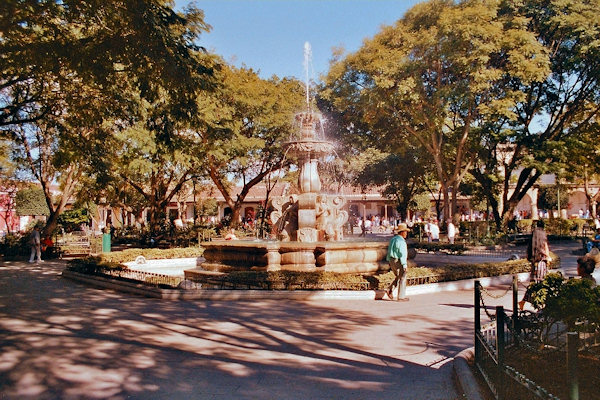 |
|||||
Parque Central
This broad and beautiful plaza, easily the loveliest in the country, is the gathering place for Antiguenos and visitors alike -
a fine, verdant place to sit or stroll and observe Antiqua happening around you, from hawkers and shoe-shiners to school kids and
groups of tourists.
The famous Fountain is a 1936 reconstruction of the original 1738 version.
Dating from 1558 the Palacio de los Capitanes was the governmental centre of all Central America from Chipas to Costa Rica
until 1773. Today the palace houses the tourist office and the national police.
On the east side of the park, Cathedral de Santiago was begun in 1542, demolishwed in 1668, rebuilt betweeen 1669 and 1680,
repeatedly damaged by eartquakes, wrecked in 1773, and only partly rebuilt between 1780 and 1820.
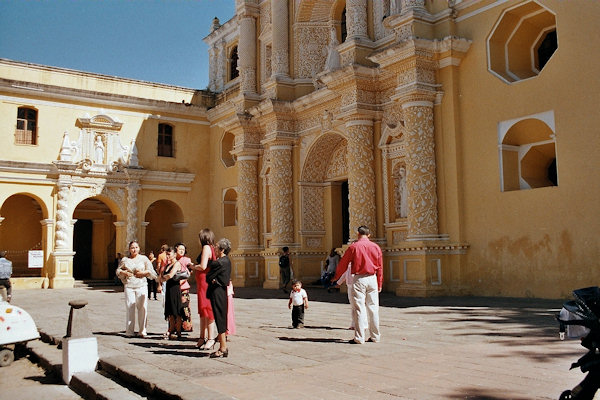 |
|||||
The city hall Palacio del Ayuntamiento, on the north side of the park, dates from 1743. It now houses some museums.
Iglesia y convento de Nuestra Señora de La Merced
The Mercedarians were the first to establish a male monastery at the former Santiago de Guatemala. The cross in stone at the
atrium and the rooms behind the main altar are the oldest structures in La Merced and date from the seventeenth century.
Lily motifs (traditionally a symbol of power for Mayan lord's) appear on the church's entrance, suggesting the influence of
indigenous labores used to construct La Merced
The Santa Catalina Arch was built in the 17th century; it originally connected the Santa Catalina Convent to a school,
allowing the cloistered nuns to pass from one building to the other without going out on the street. A clock on top was added in the
era of the Central American Federation, in the 1830s.
Pacaya Vulcano
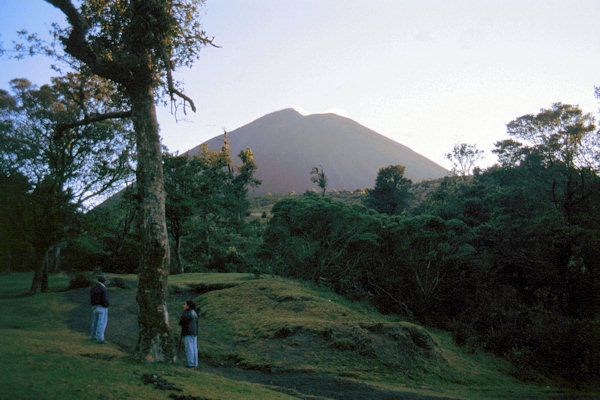 |
|||||
For an active-volcano experience taka a tour to the Pacaya Vulcano (2.552m). It's about an hour drive out of
Antigua.
Take sensible precautions; wear adequate footwear (volcano rock can be very rough on shoes) warm clothing (it can be very cold up
there) and in the rainy season, some sort of rain gear.
Carry a flashlight (torch) in case the weather changes; it can get as dark as night when it rains on the mountain and don't
neglect food and water.
It's safest to go with a reputable agency (there are plenty in Antiqua); they will drive you at the end of a dirty road, from where
it's about a two hours walk to the summit, where the vieuws are spectacular.
Chichicastenango
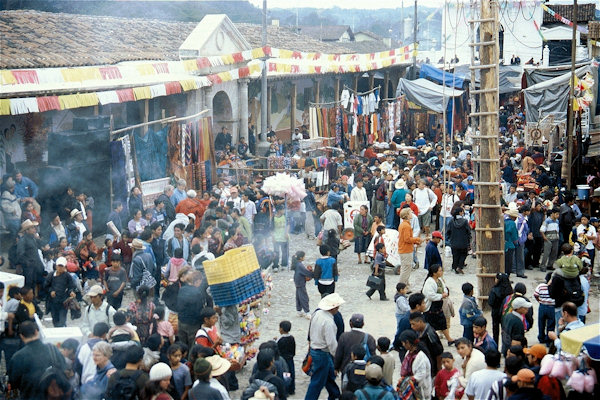 |
|||||
On thursday and sunday, Chichicastenango holds one of Guatemala's largest indigenous market.
The villagers spread out there vegetables, fruits. chunks of chalk (ground to a powder, mixed with water and used to softendried
maze), balls of wax, handmade harnesses and other merchandise and wait for customers.
Tourist-orientated handcraft stalls selling masks, textiles, potery and so on also occupy the plaza and the streets around.
Iglesia de Santo Tomas
This church on the east side of the plaza dates from about 1540 and is often the scene of rituals that are only slightly Catholic
and more distinctly Mayan.
Inside, the floor of the church may be spread with pine boughs and dotted with offerings of maize kernels, flowers, botles of liquor
wrapped in corn husks, and candles.
Many local families can trace their lineage back centuries, some even to the ancient kings of the K'iche.
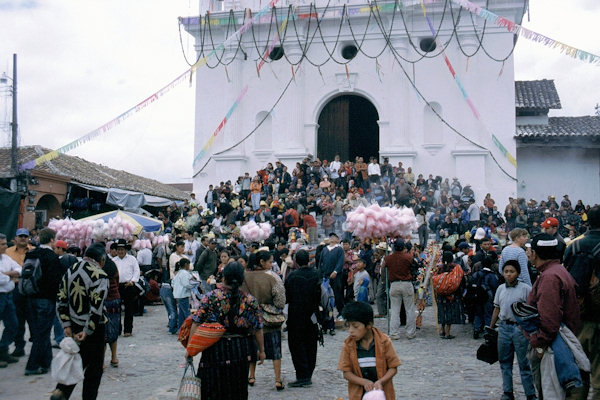 |
|||||
The candles and offerings on the floor are in remembrance of those ancestors, many of whom are buried beneath the church floor.
Photography is not permitted in this church.
Cemetry
On the west side off town lyou can find the cementry. Its a silent coulorful place, also worth a visit.
On a hilltop south of the town Pascual Abaj (sacrifice stone) is a shrine to the Mayan earth god Huyup Tak'ah
(mountain Plain).
Said to be hundreds - perhaps thousands - of years old, the stone-faced idol has suffered numerous indignities at the hands of
outsiders, but local people still revere it.
Chuchkajaues (indigenous prayer leaders) come regularly to offer incense, food, cigarettes, flowers, liquor, Coca-Cola,
and perhaps even to sacrifice a chicken, in thanks and hope for the Earth's continuing fertility.
Panajachel
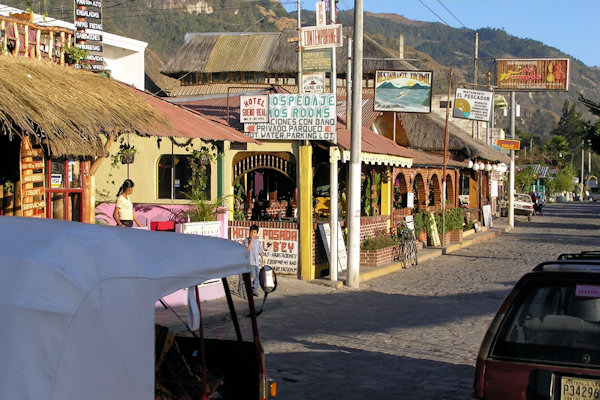 |
|||||
The busiest and most built-up lakeside settlement, Panajachel has developed haphazardly and, some say, in a less than
beautiful way. Strolling the main street, Calle Santander, crammed with cybercafes, travel agencies, handicraft hawkers and rowdy
bars, dodging noisome tuk-tuks all the way, you may be forgiven for supposing this paradise lost.
Panajachel is not a particularly beutiful place, but you only need to head down to the shore of the Lago de Atitlan to
understand why it attracts so many visitors.
Surrounded by vulcanoes, steep hilsides and villages, with traditional Mayan culture, the Lago de Atitlan - 8km across from north to
south, 18km from east to west, and averaging aroun 300m deep - is one of the world's most beautiful and fascinating bodies of water.
Many travelers have fallen in love withit and made their homes here.
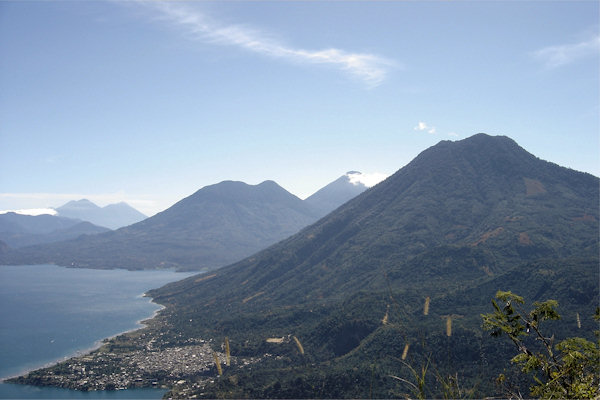 |
|||||
Maximon
The spanish called him San Simon,the ladinas named him Maximon and the Maya Know him as Rilaj Maam. By any name he is a
deity revered throughout the Guatemalin highlands.
Assumed to be a combination of Mayan Gods, Pedro de Alvarado (the Spanish conquuistador of Guatamala) and the biblical
Judas, Maximon is an affigy to witch Guatemalans of every stripe go to make offerings and ask for blessings
The effigy is usualy housed by a member of a confrada (Mayan Catholic Brotherhood), moving from one place to another, from year
to year.
In Santiago Antillan , Maximon is a wooden figure draped in coulorful silkscarves and smoking a fat sigar
Fruits and gaudy, flashing electric lights decorate his chamber; effigies of Jesus Christ and Christian saints lie or stand either
side of Maximon and his guardians.